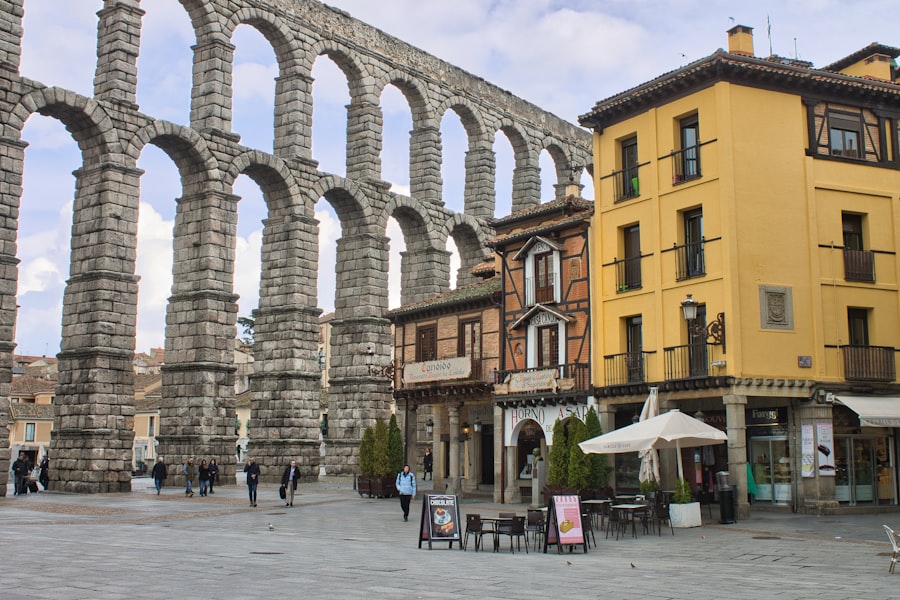The Great Pyramids of Giza stand as monumental testaments to the ingenuity and engineering prowess of ancient civilizations. Constructed around 2580–2560 BC, these iconic structures were built as tombs for the pharaohs, showcasing not only the wealth and power of the rulers but also the advanced techniques employed by the ancient Egyptians.
6 meters and was the tallest man-made structure in the world for over 3,800 years.
The precision with which these pyramids were constructed is nothing short of astounding, with each stone block weighing several tons and fitted together with remarkable accuracy. The construction methods used to build the pyramids remain a topic of fascination and debate among historians and archaeologists. It is believed that a combination of skilled labor, innovative tools, and a deep understanding of mathematics and astronomy played crucial roles in their creation.
Workers likely used ramps to transport the massive stones from quarries to the construction site, while aligning the pyramids with celestial bodies demonstrated their advanced knowledge of astronomy. The Great Pyramids not only served as burial sites but also as symbols of the ancient Egyptians’ beliefs in the afterlife, reflecting their complex spiritual and cultural values. Here is the link to the Antikythera Mechanism documentary: Antikythera Mechanism documentary.
Key Takeaways
- The Great Pyramids of Giza showcase the incredible engineering skills of ancient Egyptians, with precise construction and alignment that still baffles experts today.
- The Roman Aqueducts demonstrate the mastery of water management and engineering, providing a reliable water supply to cities and towns across the Roman Empire.
- The Colosseum stands as a remarkable example of architectural and engineering prowess, with its innovative design and advanced construction techniques.
- The Hanging Gardens of Babylon highlight the ancient Mesopotamians’ advanced knowledge of irrigation and horticulture, creating a stunning oasis in the desert.
- The Parthenon exemplifies the brilliance of classical Greek architecture and engineering, with its iconic columns and intricate design still admired centuries later.
The Roman Aqueducts: Masterpieces of Water Management
The Roman aqueducts represent one of the most significant achievements in ancient engineering, showcasing the Romans’ unparalleled ability to manage water resources. These impressive structures were designed to transport fresh water from distant sources into cities and towns, ensuring a reliable supply for drinking, bathing, and irrigation. Spanning hundreds of miles, the aqueducts utilized gravity to move water along a carefully calculated gradient, demonstrating an advanced understanding of hydraulics and engineering principles.
The construction of aqueducts involved meticulous planning and execution. Engineers had to survey landscapes, design intricate channels, and build bridges and tunnels to navigate obstacles. The most famous aqueduct, the Aqua Appia, was built in 312 BC and set the standard for future projects.
The use of arches allowed for greater stability and reduced material costs, while also creating visually striking structures that have stood the test of time. The aqueducts not only improved public health by providing clean water but also contributed to the growth and prosperity of Roman cities, highlighting the importance of effective water management in ancient societies.
The Colosseum: A Spectacular Feat of Architecture and Engineering

The Colosseum, an iconic symbol of ancient Rome, stands as a remarkable feat of architecture and engineering that has captivated audiences for centuries. Completed in AD 80 under Emperor Titus, this grand amphitheater could hold up to 80,000 spectators who gathered to witness gladiatorial contests, animal hunts, and other public spectacles. Its elliptical shape and tiered seating arrangement exemplify Roman architectural innovation, allowing for optimal viewing angles and crowd management.
Constructed primarily from travertine limestone, tuff, and brick-faced concrete, the Colosseum’s design incorporated advanced engineering techniques such as vaults and arches that provided structural integrity while minimizing material usage. The arena featured a complex system of underground passages known as the hypogeum, where animals and gladiators awaited their turn to enter the arena. This intricate design not only enhanced the spectacle but also demonstrated the Romans’ understanding of crowd dynamics and safety measures.
The Colosseum remains a testament to Rome’s architectural legacy, reflecting both its grandeur and its darker aspects of entertainment.
The Hanging Gardens of Babylon: A Wonder of Ancient Irrigation and Horticulture
| Aspect | Details |
|---|---|
| Location | Babylon, near present-day Hillah, Babil in Iraq |
| Construction | Believed to have been built around 600 BCE by King Nebuchadnezzar II |
| Height | Estimated to be around 75 feet high |
| Structure | Multi-level terraces with a variety of plants and trees |
| Irrigation | Used a complex system of water channels and pumps to bring water from the Euphrates River |
| Status | Considered one of the Seven Wonders of the Ancient World |
The Hanging Gardens of Babylon are often regarded as one of the Seven Wonders of the Ancient World, celebrated for their breathtaking beauty and innovative irrigation techniques. Although their existence remains a subject of debate among historians, they are said to have been built in the ancient city-state of Babylon around 600 BC by King Nebuchadnezzar II for his wife, Amytis. The gardens were described as a series of tiered terraces filled with a variety of trees, shrubs, and vines that created a lush oasis in an arid landscape.
The engineering behind the Hanging Gardens is particularly noteworthy. To sustain such an elaborate garden in a region with limited water resources, it is believed that an advanced irrigation system was employed. This system may have included pumps or aqueducts to draw water from the Euphrates River, allowing it to flow through channels that nourished the plants on each terrace.
The gardens not only showcased horticultural expertise but also reflected the Babylonians’ understanding of environmental management and their desire to create beauty amidst harsh conditions.
The Parthenon: A Triumph of Classical Greek Architecture and Engineering
The Parthenon stands as a quintessential example of classical Greek architecture, embodying the ideals of beauty, harmony, and proportion that defined ancient Greek culture. Constructed between 447 and 432 BC on the Acropolis of Athens, this temple was dedicated to Athena Parthenos, the city’s patron goddess. Its Doric design features iconic columns that taper slightly towards the top, creating an optical illusion that enhances its grandeur.
Beyond its aesthetic appeal, the Parthenon showcases remarkable engineering techniques that have allowed it to endure for centuries. The use of entasis—slight curvature in columns—corrects visual distortions that would otherwise occur in straight lines when viewed from a distance. Additionally, the temple’s intricate sculptures and friezes depict mythological scenes that reflect Athenian values and beliefs.
The Parthenon not only served as a religious site but also as a symbol of Athenian democracy and cultural achievement, representing a pinnacle of ancient engineering and artistic expression.
The Great Wall of China: An Astonishing Defensive Structure

The Great Wall of China is one of the most ambitious construction projects in human history, stretching over 13,000 miles across northern China. Originally built to protect against invasions from nomadic tribes, this monumental structure showcases the ingenuity and determination of various Chinese dynasties over centuries.
The engineering behind the Great Wall is both impressive and complex. It features watchtowers for surveillance, barracks for soldiers, and signal fires for communication across vast distances. The wall’s design varied according to geographical conditions; in mountainous areas, it was constructed with steep slopes for added defense, while in plains it took on a more straightforward form.
Despite its primary purpose as a military fortification, the Great Wall also served as a symbol of national unity and strength throughout Chinese history.
The Pantheon: A Marvel of Roman Concrete Engineering
The Pantheon is often hailed as one of the greatest architectural achievements of ancient Rome, renowned for its massive dome and innovative use of concrete. Completed around AD 126 during Emperor Hadrian’s reign, this temple dedicated to all gods features a rotunda with an oculus at its center that allows natural light to illuminate its interior. The dome remains one of the largest unreinforced concrete structures in existence today.
The engineering techniques employed in constructing the Pantheon were revolutionary for their time. Roman architects utilized a unique blend of volcanic ash known as pozzolana mixed with lime to create a lightweight yet durable concrete that could span vast spaces without support columns. The dome’s thickness decreases from 6.2 meters at its base to just 1.2 meters at the oculus, demonstrating an understanding of structural integrity while minimizing weight.
The Pantheon not only exemplifies Roman engineering prowess but also serves as an enduring symbol of architectural innovation that continues to inspire modern architects.
The Lighthouse of Alexandria: A Beacon of Ancient Maritime Engineering
The Lighthouse of Alexandria, also known as the Pharos of Alexandria, was one of the tallest man-made structures in the ancient world and a marvel of maritime engineering. Constructed on the small island of Pharos around 280 BC during the reign of Ptolemy II Philadelphus, this lighthouse served as both a navigational aid for sailors and a symbol of Alexandria’s wealth and power. Standing approximately 100 meters tall, the lighthouse was built in three distinct tiers: a square base with a central core, a cylindrical middle section, and a circular top adorned with a statue—often believed to be that of Zeus or Poseidon—serving as a beacon for ships approaching the harbor.
The use of mirrors to reflect sunlight during the day and fire at night allowed it to guide vessels safely into port. Although it was eventually destroyed by earthquakes in the 14th century, its design influenced lighthouses throughout history and remains an enduring symbol of ancient engineering excellence.
The Mayan Pyramids: Ingenious Structures of Mesoamerican Engineering
The Mayan pyramids are remarkable examples of Mesoamerican engineering that reflect both religious significance and advanced architectural techniques. Constructed between 250 AD and 900 AD across present-day Mexico, Guatemala, Belize, Honduras, and El Salvador, these pyramids served as temples for worshipping deities and conducting rituals. Each pyramid was often part of larger ceremonial complexes that included plazas and other structures.
One notable example is El Castillo at Chichen Itza, which features a step pyramid with 91 steps on each side—symbolizing the days in a year—culminating in a temple at its summit. The Mayans demonstrated exceptional knowledge in astronomy; during equinoxes, shadows cast by the pyramid create an illusion resembling a serpent slithering down its steps—a testament to their intricate understanding of celestial movements. These structures not only served religious purposes but also showcased Mayan society’s architectural ingenuity and cultural sophistication.
The Inca Road System: A Remarkable Network of Ancient Engineering
The Inca Road System is one of history’s most extensive networks of roads and trails, stretching over 25,000 miles across rugged Andean terrain. Built during the height of the Inca Empire in the 15th century, this remarkable feat of engineering facilitated communication, trade, and military movement throughout their vast territory. The road system connected various regions from modern-day Colombia to Chile, showcasing an impressive understanding of geography and logistics.
Inca engineers employed various techniques to adapt their roads to diverse landscapes—constructing bridges over rivers, carving paths into mountainsides, and creating stairways through steep terrain. They also developed way stations known as tambos where travelers could rest or resupply along their journey. This intricate network not only enabled efficient transportation but also fostered cultural exchange among different communities within the empire.
The Inca Road System remains an enduring legacy that highlights their remarkable engineering capabilities.
The Temple of Artemis at Ephesus: A Monument to Ancient Greek Engineering Brilliance
The Temple of Artemis at Ephesus is often regarded as one of the most magnificent temples ever constructed in ancient Greece. Built around 550 BC in honor of Artemis—the goddess of hunting and fertility—this temple was renowned for its grandeur and architectural sophistication. It stood as a testament to both religious devotion and engineering excellence during its time.
Designed by architect Chersiphron and his son Metagenes, the temple featured 127 columns standing at 18 meters high—each intricately carved with exquisite reliefs depicting scenes from mythology. Its layout incorporated advanced techniques such as raised platforms to elevate its prominence within Ephesus’ landscape while allowing for optimal drainage during heavy rains. Despite being destroyed multiple times throughout history—most notably by arson in 356 BC—the Temple of Artemis remains an enduring symbol of ancient Greek engineering brilliance that continues to inspire awe today.
In conclusion, these remarkable structures from various ancient civilizations reflect not only their architectural prowess but also their cultural values and technological advancements. Each monument tells a story about human ingenuity in overcoming challenges posed by nature while leaving behind legacies that continue to captivate generations long after their creation.
Sophisticated ancient engineering has long fascinated historians and archaeologists, revealing the remarkable capabilities of past civilizations. One intriguing article that delves into this topic is found on XFile Findings, which explores various ancient structures and the advanced techniques used in their construction. You can read more about these engineering marvels in the article [here](https://www.xfilefindings.com/).
WATCH THIS! The Antikythera Mechanism Is Not Human Tech
FAQs
What is sophisticated ancient engineering?
Sophisticated ancient engineering refers to the advanced and complex engineering techniques and technologies used by ancient civilizations to construct impressive structures, such as pyramids, aqueducts, and temples.
Which ancient civilizations were known for their sophisticated engineering?
Several ancient civilizations were known for their sophisticated engineering, including the Egyptians, Greeks, Romans, Mayans, and Incas.
What are some examples of sophisticated ancient engineering achievements?
Examples of sophisticated ancient engineering achievements include the construction of the Great Pyramid of Giza, the aqueducts of ancient Rome, the Parthenon in Athens, and the Inca citadel of Machu Picchu.
What advanced engineering techniques were used by ancient civilizations?
Ancient civilizations used advanced engineering techniques such as precision stone cutting, complex irrigation systems, architectural design, and the use of advanced materials like concrete and metal alloys.
How did ancient civilizations acquire the knowledge and skills for sophisticated engineering?
Ancient civilizations acquired the knowledge and skills for sophisticated engineering through trial and error, observation of natural phenomena, and the passing down of knowledge from generation to generation. They also developed advanced mathematical and scientific principles to aid in their engineering endeavors.
What is the significance of studying sophisticated ancient engineering?
Studying sophisticated ancient engineering provides insights into the technological capabilities and ingenuity of ancient civilizations, as well as the cultural, social, and economic factors that influenced their engineering achievements. It also helps us understand the evolution of engineering and its impact on human history.
